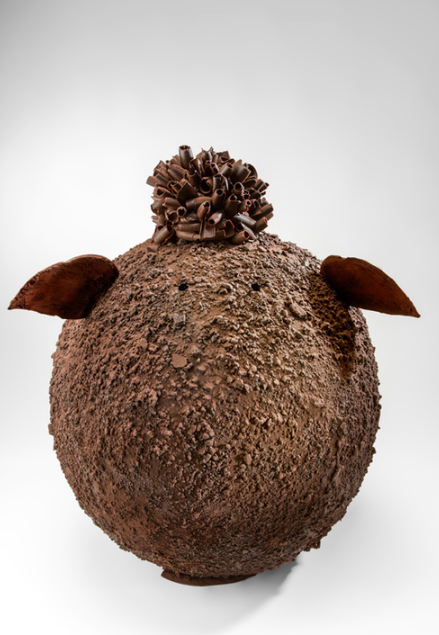Is it stretching the truth to label Chocolate as health food ?
Our favourite Dietitian Lorna Garden gives us permission to enjoy Chocolate over the Easter period….
With Easter fast approaching, an extra food group will soon be added to the daily intake of most Australians. From milk chocolate, foil wrapped bilbys to fairtrade, dark, organic, goji berry easter eggs, there is something for everyone!
But how does this important food, chocolate, fit into the life of an athlete who has performance and body composition goals to consider at this time?
Chocolate is usually made from cacoa or cocoa, cocoa liquor, cocoa butter, sugar or alternative sweetener, emulsifier (lecithin) and flavour (vanilla, fruit, spices etc.).
Cacao is a tree that can grow very tall (up to 12 metres) and it produces fruit called pods or cabossides, which contain from 20-40 cacoa beans. These beans are dried and ground to produce raw cacao, or roast, shelled and ground to produce cocoa and cocoa liqueur, which are used in most commercial chocolate products today.
Whilst raw cacao is always going to be the more natural option, with high levels of antioxidants, stimulants and minerals, cocoa (particularly organic) still offers good levels of all of these important components.
Until recently chocolate has been considered by most as a guilty pleasure, however good news has come in the form of research which suggests that cacoa, cocoa and chocolate (dark in particular as it contains more cocoa) are rich in plant polyphenols and flavonols which are strong antioxidants.
In particular, compounds known as catechins have been shown to have a possible role in helping protect against heart disease and cancer.
Chocolate is noted to have anti-inflammatory, neuroprotective and cardioprotective effects, and improves the bioavailability of nitric oxide, which improves blood pressure, platelet function and fluidity of blood. In addition, it contains a number of psychoactive substances including serotonin and phenylethylamine which control mood, and offer the “antidepressant” effect of chocolate.
And if that’s not enough, cocoa contains caffeine, theophylline and theobromine which are all stimulants with a number of possible performance enhancing effects.
Whilst we desperately await direct research showing that cocoa and chocolate enhances sports performance, we can take comfort in recent studies from the exercise physiology labs looking at the role of chocolate milk in recovery.
Several studies have shown that chocolate milk supplies a carbohydrate-protein combination that maximizes post workout recovery, it contains calcium and vitamin D which promote overall muscle, bone, and cardiovascular health, is rich in electrolytes, and is a good source of fluids for post-exercise replacement of sweat losses.
So, chocolate for breakfast, lunch and dinner for maximum performance?
Probably not.
Chocolate is still an energy dense food, and many varieties contain significant amounts of added sugar and around 30-45% fat (although this fat has a high proportion of stearic acid which does not have the same cholesterol raising
effect that other saturated fats do). Like any high fat/high sugar food, when eaten in excess, chocolate can have an adverse effect on body fat levels, and can replace nutritious foods like fruits, vegetables, nuts and grains.
So whilst chocolate shouldn’t be your main fuel source each day, it can certainly be enjoyed by most athletes, in moderation. Here are my tips on healthy ways to include chocolate in a high performance eating regime
-
Choose dark chocolate – at least 75% cocoa
-
Buy good quality, organic, fair trade chocolate
-
Enjoy a small amount, eaten slowly and without guilt
-
As a general rule, eat chocolate after training or competition, not before
-
Ultra-endurance athletes may be able to tolerate a little dark chocolate in a nutritious bar or in a trail mix
-
Blend together cacoa or cocoa, frozen banana & coconut yoghurt for a healthy dessert or snack
-
Grab a chocolate milk for recovery after a hard workout (or make your own cacoa smoothie)
-
Blend a little dark chocolate or cocoa with raw nuts, fresh dates and vanilla and roll into balls for yummy ‘power balls’
-
Drizzle a little melted chocolate over fresh fruit (berries, kiwi, bananas, pears, dates etc.) for a treat
-
For a healthy chocolate mousse – blend raw cacoa with ripe avocado and a little agave or coconut nectar, & vanilla and refrigerate
Lorna Garden APD is a registered and practising dietitian specialising as a sports dietitian accSDA and a Preferred Practitoner with ASkinSolutions. Lorna has a passion for ‘fit food’- whole fresh foods that nourish, inspire, energise and create an healthy body and mind. Lorna works with a range of individuals, offering creative solutions for meeting nutrition and lifestyle goals







